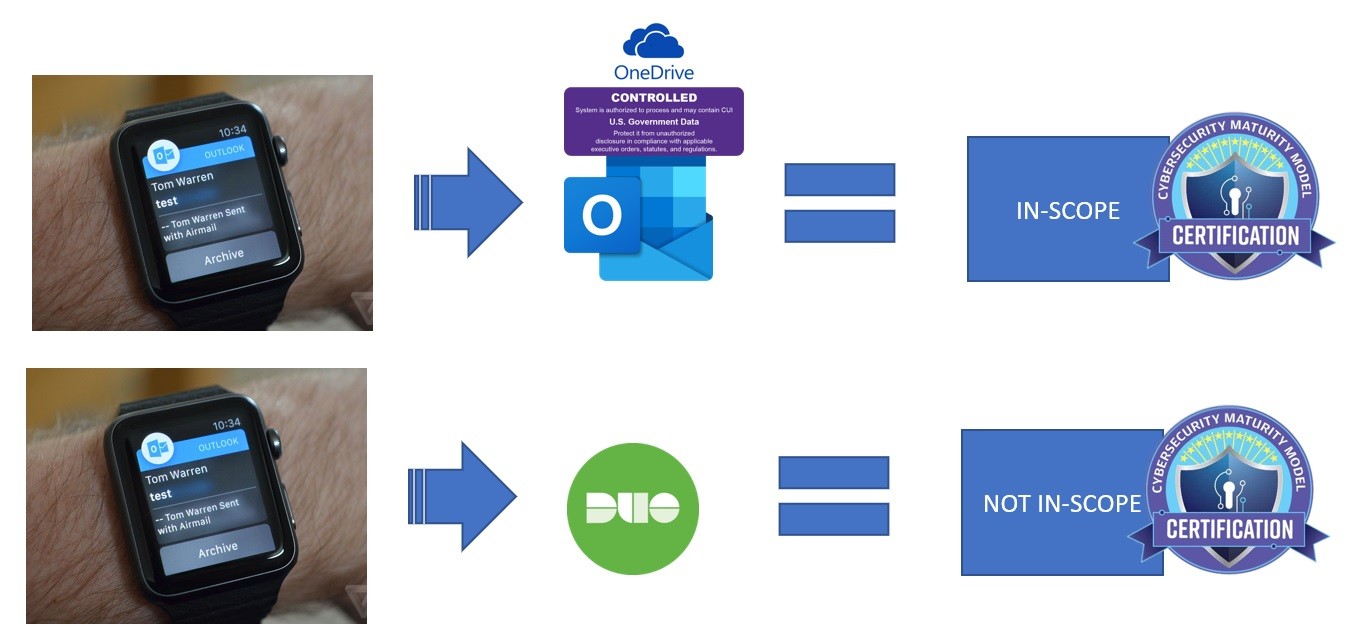This is a short article on understanding on how smart watches can potentially fall in-scope for the NIST SP 800-171 / Cybersecurity Maturity Model Certification (CMMC) Maturity Level 3 requirements.
We often think about our cell phones, laptops, and desktops as information systems, but tend to forget the growing trend of smart watches. Which have all the capabilities of the above-mentioned devices. When you look at DFARS 252.204-7012, there are several definitions to keep in mind.
What is considered an information system?
First, an Information System means, “a discrete set of information resources for the collection, processing, maintenance, use, sharing, dissemination, or disposition of information.” This definition would encompass smart watches and similar technologies.
Next, Covered Defense Information means, “unclassified controlled technical information or other information, as described in the Controlled Unclassified Information (CUI) Registry, that requires safeguarding or dissemination controls pursuant to and consistent with law, regulations, and Governmentwide policies…”
Lastly, Covered Contractor Information System means, “an unclassified information system that is owned, or operated by or for, a contractor and that processes, stores, or transmits Covered Defense Information.“
Is your smart watch in-scope?
If you receive an email that contains CUI on your smart watch, your smart watch will now be in-scope for meeting CUI security requirements. Similarly, if you open a document containing CUI from an online cloud storage application using your smart watch, your smart watch will also be in-scope for meeting CUI security requirements.
Let’s look at how NIST SP 800-171‘s concepts of “security domains” can be used to determine how smart watches would be scoped. If you used your smart watch to process, transmit, and/or store CUI data, your smart watch would be subject to the CMMC CUI protection requirements (i.e., it would be in-scope and reviewed as part of your CMMC assessment) because it is used to “process, store, or transmit CUI, or…provide[s] security protection for such components” (NIST SP 800-171 Revision 2, Section 1.1, 2nd Paragraph). This would also be true for other applications that are used to process CUI, including, without limitation:
- Viewing/sending/receiving emails via email application such as Outlook
- Editing/viewing documents in cloud storage applications such as One Drive
Your watch and multifactor authentication
Where things get more interesting is if you only used your smart watch to approve a multifactor authentication prompt, rather than handling CUI, your device might not be in-scope. Although a multifactor authentication service, such as Cisco Duo Security or Microsoft Authenticator, could be seen as providing security protection for “components” that handle CUI, it is not clear that NIST or DoD would consider the smart watch as being in-scope since all you would be doing is “pushing a button”. Also, it is not clear whether or not personal devices are authorized on a Covered Contractor Information System. DoD has indicated that they will publish scoping guidance in the near future, and hopefully that guidance will help clarify these kinds of issues.

In order to avoid this common and often overlooked issue, organizational policy should dictate either the use or prohibition of smart watches in order to protect the confidentiality of CUI. As a security best practice, it is best to remove all applications from your smart watch where CUI could potentially be processed, stored, and/or transmitted.
Recent Posts
- How Technology Is Transforming C3PAO Assessment Process
- Top Mistakes That Can Delay Your CMMC Assessment And How To Avoid Them
- The Hidden Value Of Professional CMMC Certification Services For DoD Contractors
- CMMC Compliance Made Practical: Strategies That Actually Work For Contractors
- How CMMC News Is Changing The Rules For Government Contractors
Search
Recent Comments
Recent Posts
- How Technology Is Transforming C3PAO Assessment Process October 15, 2025
- Top Mistakes That Can Delay Your CMMC Assessment And How To Avoid Them October 14, 2025
- The Hidden Value Of Professional CMMC Certification Services For DoD Contractors September 30, 2025
- CMMC Compliance Made Practical: Strategies That Actually Work For Contractors September 10, 2025
Archives
- October 2025 (2)
- September 2025 (4)
- August 2025 (2)
- July 2025 (6)
- June 2025 (8)
- April 2025 (9)
- March 2025 (5)
- February 2025 (1)
- January 2025 (8)
- December 2024 (7)
- October 2024 (2)
- March 2024 (1)
- February 2024 (1)
- January 2024 (1)
- December 2023 (1)
- August 2023 (1)
- July 2023 (1)
- June 2022 (1)
- April 2022 (1)
- November 2021 (1)
- June 2021 (1)
- May 2021 (1)

Recent Comments